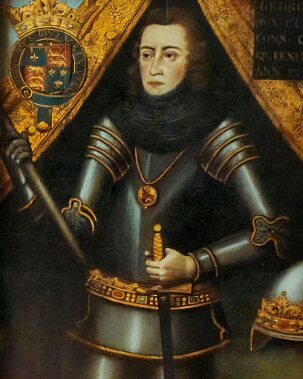12 March 1470
King Edward IV had been captured and imprisoned in July 1469 by his over-mighty subject Richard Neville Earl of Warwick. Edward however, refused to be a puppet king and with the support of his loyal youngest brother Richard, Duke of Gloucester, the king regained control of the government. Despite being reconciled with his cousin the king, by March 1470 Warwick remained dissatisfied, far from being the power behind the throne, he found himself in a similar position to that which he had occupied before the rebellion and was unable to exercise any control over Edward's policies.
George, Duke of Clarence
To regain his sphere of influence, Warwick wished to place the middle York brother, George, Duke of Clarence, who was married to his eldest daughter Isabel, on the throne and called on former supporters of the defeated House of Lancaster to aid him in a further planned rebellion against Edward.
During the autumn and winter of 1469 - 1470, Robert Welles, Baron Welles and 8th Baron Willoughby de Eresby, the son and heir of Richard Lord Welles, a former Lancastrian, and in league with Warwick and Clarence, squabbled with his neighbour Sir Thomas Burgh of Gainsborough. Welles, his son Robert and his brothers in law, Sir Thomas de la Lande and Sir Thomas Dymmock took Burgh's property. Sir Thomas Burgh was Edward's Master of Horse and the king accordingly took up his cause.
Edward began to gather an army to oppose the rebels. When the news arrived in Lincolnshire it quickly spread panic. Due to Welles' deliberate misinterpretation, the rumours stated that the King was marching on Lincolnshire not to relieve Sir Thomas Burgh but to try the previously pardoned rebels from the Battle of Edgecote Moor, and that he intended to have vengeance and "hang and draw a great number" of them and was intent on laying waste to Lincolnshire.
With the aid of Warwick and Clarence, Sir Robert Welles set himself up as a "captain of the commons of Lincolnshire". On 7 March, Edward received news that the rebels were advancing to Stamford with a 100,000 strong army, he later received communications from both Clarence and Warwick stating they were advancing north to support the King. Edward, unsuspecting foul play, issued commissions of array, authorising Warwick to raise his own army.
Before leaving London to deal with the uprising, Edward met Clarence at their mother Cecily Neville's London home of Barnard's Castle, where Clarence reassured his brother that he was en route to his estates. Edward was content with this and began his march north to confront the rebels. Clarence, Shakespeare's 'quicksand of deceit then travelled to the Hospital of St. John's at Clerkenwell where he held a clandestine meeting with Welles.
On 11 March, Edward reached Fotheringhay were further news arrived that the rebels had changed course for Leicester, as had Warwick and Clarence also, no doubt providing the King with a good idea of their true intentions. Edward dispatched a letter to Sir Robert Welles ordering him to disband his army, or his father Lord Welles, who was in Edward's custody, would be executed. His father Lord Welles also wrote to Robert, to prevail with him to abandon his rebellion. At which Welles hastily turned back his army to Stamford failing to rendezvous with Warwick.
Battle of Losecote Field
Welle's army was situated around five miles from Stamford in Rutland, lined up in battle array beside the Great North Road to the north of Tickencote Warren near Empingham. Edward drew up his battle lines to the north of the rebel army, and in the space separating the two armies, ordered the execution of Lord Welles and Thomas Dymmock in full view of both armies. The rebels advanced in response to the cries of a Warwick and a Clarence. After a single barrage of cannonballs was fired, Edward ordered his men to charge.
The battle was over before a blow was struck, the rebels lost their nerve and fled and a complete rout followed. The site of the battle still retains the name Bloody Oaks. In proof of Clarence's complicity in the rebellion, one of the dead rebels, dressed in his livery, was found to have been carrying correspondence from Clarence to Sir Robert Welles. Both the rebel captains, Sir Robert Welles and his commander of foot Richard Warren were taken prisoner during the rout, Welles confessed and named Warwick and Clarence as the "partners and chief provokers" of the rebellion. Welles and Warren was executed at Doncaster a week later on 19 March.
The curious name of the battle has been explained by the fact that many of the rebels were wearing jackets displaying the livery of Warwick and Clarence. Fearing to be caught wearing such identification when the rout began, many of them discarded their coats and thus the battle came to be referred to as "Lose-coat Field ". However, contemporary evidence does not bear out this explanation, which appears to have been first recorded in the nineteenth century. Contemporary accounts refer to the battle site as "Hornfield" and do not mention the name Losecoat. The name probably derives from an Old English phrase hlose-cot meaning "pigsty cottage". Forms of Losecote also appear as field names in other parishes in Rutland. A field at the site of the battle seems also to have acquired that name.
Warwick and Clarence promptly took ship for Calais with the countess of Warwick, Anne Neville, and the heavily pregnant Isabel, Duchess of Clarence, and promptly fled the country. Isabel's child was stillborn and buried at sea. An exile in France, under the auspices of Louis XII, the embittered Warwick renewed his allegiance to the dispossessed Lancastrian queen, Margaret of Anjou, which was cemented by the marriage of his younger daughter, Anne Neville, to Edward Plantagenet, the Lancastrian Prince of Wales, the heir of Henry VI.
The Battle of Edgecote Moor PreviousNext The Battle of Barnet
